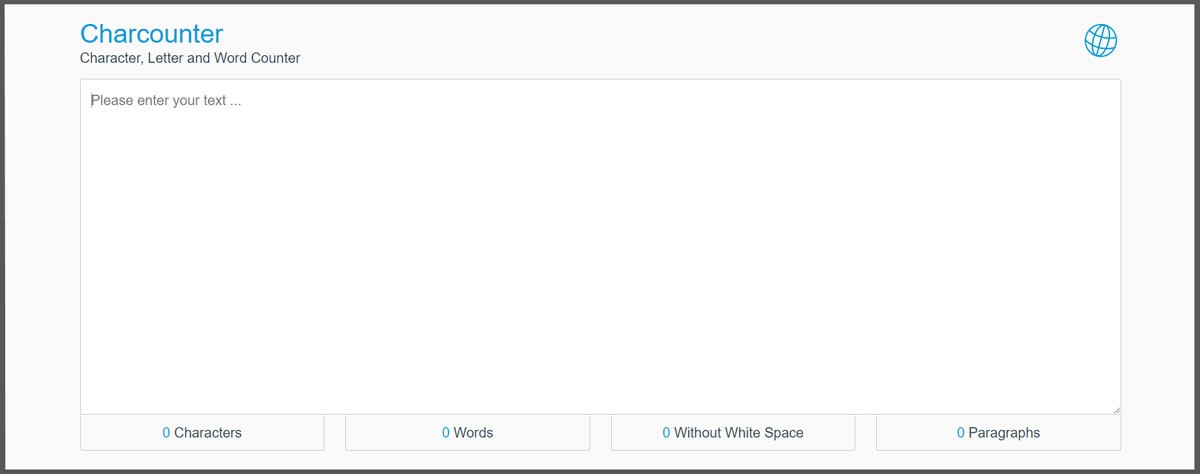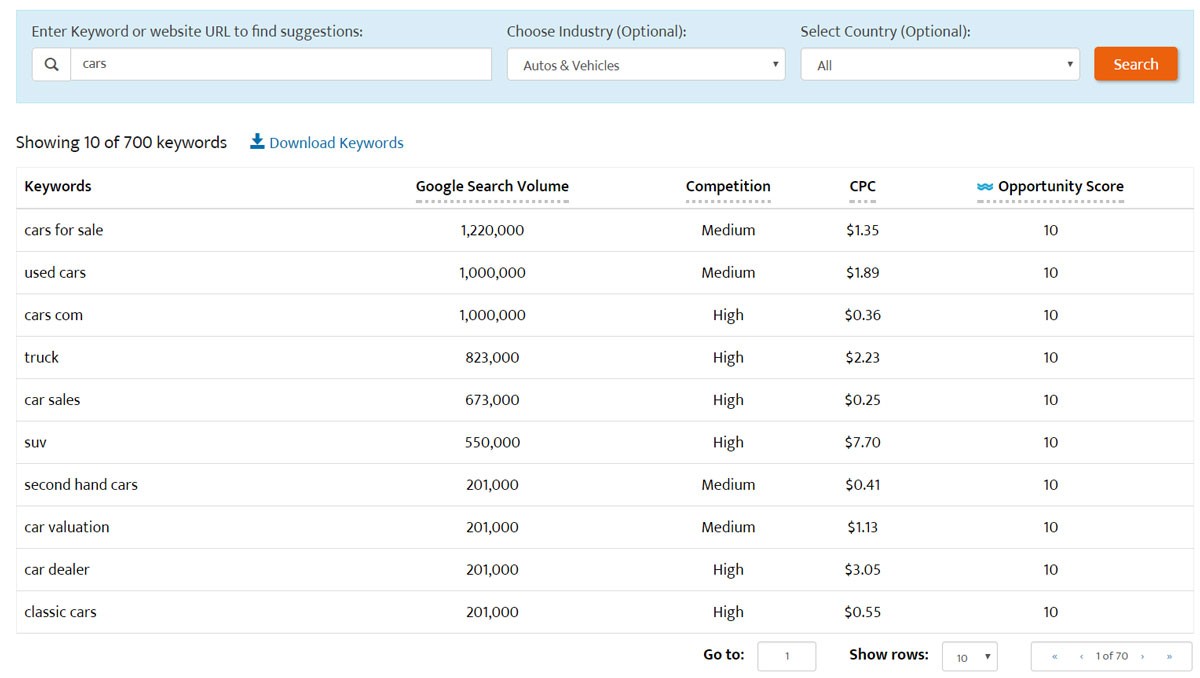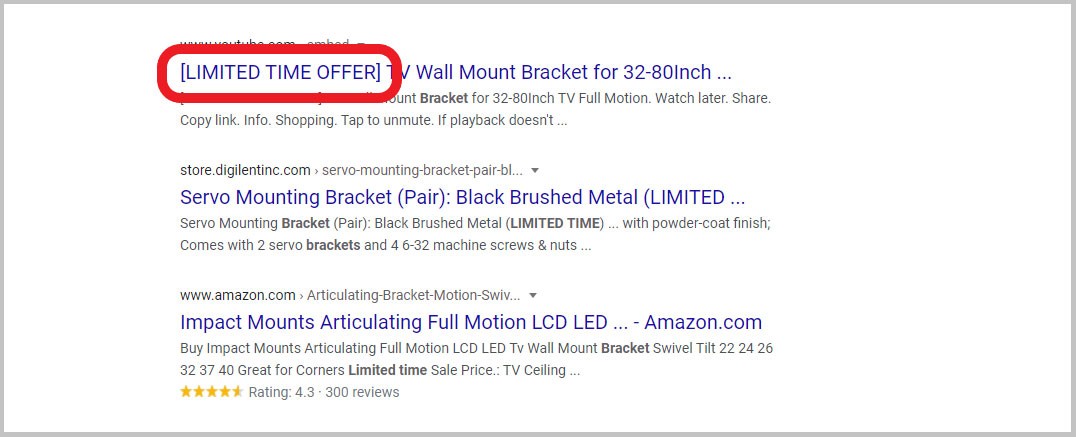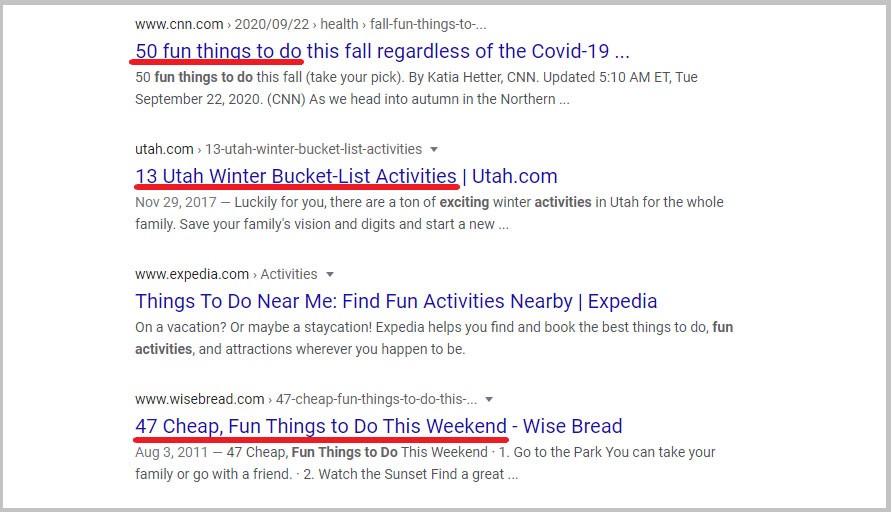When it comes to search engine optimization, your title tags are one of the most important on-page SEO factors for determining your placement in the search engine rankings. This means that paying special attention to things like the keywords you include in your title and your title length are extremely important. Needless to say, failing to add the proper SEO elements to your title tag can result in your web pages getting pushed down the search engine rankings and buried.
What’s important to remember when it comes to writing title tags is that SEO isn’t the only thing that you need to take into consideration. Not only do your title tags have a large effect on your search engine ranking, they also play a large role in determining how many people actually click through to your website. This means that in addition to focusing on elements such as title length SEO, you also need to make sure that your titles are well written.
The good news is that balancing SEO with good copywriting isn’t hard if you know what you’re doing. In fact, by using a few simple techniques you can write titles that get lots of clicks and give your site plenty of SEO juice. That being the case, let’s start by going over some of the hard and fast rules of title tag SEO that you want to make sure that you’re using.
FACT: 36% of SEO experts think the headline/title tag is the most important SEO element.
1. SEO Title Length
Title length SEO doesn’t just apply to pages like blog posts, it applies to every page on your site no matter how insignificant you may think it is. This is because Google and the other search engines will only show a certain number of characters when displaying your title. If your SEO title length is too long, some characters will get cut off, and your title will lose its effectiveness.
The best way to make sure that your SEO page title length falls within this limit is to use a title length character counter. There are many of these that can be found online, and using them to write your page titles will go a long way in helping you to conform to the SEO title size guidelines of Google and the other search engines. For example, here is a character counter called Charcounter:

While these tools are handy, it also helps to memorize how many characters will be displayed in the search results depending on the search engine being used. Here is a list of the SEO title length character limits for some of the most popular search engines.
- Google – 60
- Bing – 65
- Yahoo! – 25
- DuckDuckGo – 25
As you can see, the SEO title size for Yahoo! and DuckDuckGo are much shorter than Google and Bing. This is something to keep in mind when writing your title tags. If you’ve done your demographics research and have discovered that a significant portion of your traffic is coming from search engines with shorter SEO page title length limits, then you may want to use shorter titles to make sure that they make sense when displayed by these search engines.
2. Choosing the Right Keywords
In addition to title length for SEO, you also need to choose the right keywords so that you can rank for terms that will get you lots of traffic. This of course means that you should be doing both keyword and demographics research in order to find out what keywords your target audience are using to try and find your content. To ensure that you get the best results possible there are a few things to keep in mind when doing this research.
Voice Search
These days more people are using voice search to look up things online than ever before. This is because the technology behind voice recognition software has improved drastically and is now much easier to use. However, this has also had an effect on SEO title tags as well.
For one thing, the search terms that a person uses when they speak out loud can be quite different than the ones they use when typing on a keyboard. For example, a person may use voice search to look up a term like “auto parts dealer near me” but if they’re typing it out they might go for something more specific like “auto parts dealer Atlanta GA.”
Now you might be thinking that it would be ridiculous to try and target a search term like “auto parts dealer near me,” and you would be right. There are many other SEO factors that help you to rank for those kinds of search terms such as Google My Business. As far as your title tag keywords go, you want to use specific keywords that let the person doing the voice search know that they’ve found what they’re looking for even if they use a vague search term like the above example.
Basically things will flow like this: a person searches for something specific using a vague search term because they’re counting on the search engine to know what they’re talking about. The search engine then figures out what they mean and a list of results are then displayed and they click on the result that best matches their expectations.
While this may sound like it adds another layer of psychology to how you should be writing your title tags for SEO, it really doesn’t change as much as you would think. As long as your pages are getting ranked for the keywords that you’re targeting, your titles just need to let people know that they’ve found what they’re looking for so that you can get their clicks.
Test your SEO in 60 seconds!
Diib is one of the best SEO tools in the world. Diib uses the power of big data to help you quickly and easily increase your traffic and rankings. We’ll even let you know if you already deserve to rank higher for certain keywords.
- Easy-to-use automated SEO tool
- Keyword and backlink monitoring + ideas
- Speed, security, + Core Vitals tracking
- Intelligently suggests ideas to improve SEO
- Over 500,000k global members
- Built-in benchmarking and competitor analysis
Used by over 500k companies and organizations:
Syncs with 
Competitive Keywords vs Uncompetitive Keywords
The tricky thing about choosing keywords is the fact that the ones that get the most searches are also the ones that are hardest to rank for. On the other hand, if you choose less competitive keywords then you may not get as much traffic as you would like. Fortunately there is a way to overcome this dilemma.
You Might Also Like
Before you choose keywords you need to understand what your demographic is searching for in order to find what you have to offer, that’s a given. However, you also need to understand the nature of what you’re offering as well. If you run a business this means having a good understanding of your USP, your unique selling proposition. If you’re running a blog then you need to have a good idea of what your niche is.
The main thing is to really take a look at what you’re offering, and what makes it unique. Your uniqueness can help you to find keywords that are very specific and highly targeted. These keywords may get less traffic overall, but they’ll be much less competitive as well. Even better is the fact that since they’re so targeted you’ll be able to zero in on people who have a very specific interest in what you have to offer. This of course means that your clickthrough rates and conversion rates will be higher.
A good example of this idea in action would be a website that sells dog collars coming up with title tag keywords like “fancy dog collars,” “cheap dog collars,” or “spiked dog collars.” The key is to get as specific as possible with your title tag keywords instead of going broad. In this example different people want different types of dog collars so you could have different product pages for each which would allow you to use different title tags with very specific keywords for each one. If you are having a hard time deciding which keywords to use there are keyword tools out there that can help you. For example, WordStream has a tool that allows you to find out how often the keyword is searched and what the competition for said keyword is:

(Image Credit: WordStream)
3. Using Brackets and Parentheses
Fitting keywords into your title can be a messy process, especially if you have several different words that absolutely need to be in there but don’t really fit together in a coherent sentence. You can get around this problem by using brackets and parentheses to separate words and phrases so that the title flows much more naturally.
A good example of this would be writing an SEO title for a page that advertises a dog training course using a video. Instead of just writing a title that hits all of your necessary keywords, you could go a step further in putting the word “video” at the beginning of your title in brackets or parenthesis. It could be something like this: [VIDEO] How to House Train Your Dog in Less Than 2 Hours.
This technique doesn’t just apply to pages that have videos, it can apply to all kinds of things. Here is a short list of terms that you can put into brackets or parenthesis to give you some ideas:
- Special Offer
- Limited Time
- Save Now
- FREE
- WARNING
- Important
Keep in mind that the word or phrase in parentheses or brackets doesn’t have to come at the start of your title tag. You can put it at the end if you were to write something like this: Sales Page Templates (50+ High Conversion Templates!) As you can see, using this technique allows you to get in your main keywords while also adding something enticing to get clicks.
4. Copywriting for Title Tags
As mentioned earlier, the best SEO title tags are the ones that strike a balance between the keywords you want to target, and copywriting that will get people to click. Copywriting is the art of marketing and selling through the written word, and is essential for creating compelling title tags that make people want to click through to your website.
While copywriting can take years to master, you don’t need to be an expert to use powerful copywriting techniques in your title tags. This being the case, let’s take a look at some of the best copywriting elements to use when creating SEO title tags.
Present the Solution
Generally speaking people’s motives fall into two categories; things that increase pleasure, and things that decrease pain. This means that there are a lot of people searching online for things that will solve their problems. If this is applicable to your business or blog, then being able to “present the solution” in your title tags is a great way to get clicks.
Scarcity
Humans are wired psychologically to fear losing something more than they enjoy gaining something. You can take advantage of this by giving them something to lose using the element of scarcity. Things like limited time offers or a limited quantity of items are good examples of this.
Working the element of scarcity into your title tags could be as simple as putting the phrase “Limited Time” into brackets, or something like “Only 100 Left” to show the number of items remaining. Just remember that false scarcity can get you in trouble with the law so only use this strategy if it actually applies to your situation. For example:

Make a Big Promise
People will believe what they want to believe. This means that if you make a big promise in your title tag that people want to believe, they’ll be inclined to give you a click and take a look. Title tags that make big promises like “How to Relieve Gout Fast” or “Learn How to Turn $10 into $100” are good at getting clicks because even if the reader doesn’t believe it they may click anyway out of curiosity, or in the hopes of being proven wrong. For instance:

The thing to remember when using this strategy is to always make sure that you can backup your big promise. If you can’t, then you’ll likely see a high bounce rate which can harm your SEO. Misleading people will also damage your credibility and your brand.
Do Something Simple – Get Something Great
This copywriting strategy is very similar to making a big promise but with the added bonus of telling people that they only have to do something very simple in order to get it. A title tag like “Teach Your Dog to Sit in Just 5 Minutes” or “Lose Belly Fat with One Simple Exercise” are great at getting clicks because they appeal to a person’s desire to get something with minimal effort. Once again, you need to be able to deliver on your promise or your SEO could suffer as a result.
Listicles
People love numbered lists, and as a result, SEO title tags that make use of this strategy tend to get lots of clicks. Even better is the fact that listicles are a very simple format to write making it easy to create this kind of content. Examples of listicle SEO title tags include: “7 Ways to Boost Your SEO,” “5 Signs of Cancer You Should Know About,” and “Top 10 Reasons to Own a Dog.” Here are a few more examples:

5. Balancing SEO and Copywriting
Reading through this you may have noticed that some of the examples used leaded more heavily towards the SEO side of things, while others leaned more heavily towards the copywriting side. When you write title tags you want to balance SEO and smart copywriting but it won’t always be an even 50/50 split. Depending on the page, you may need more SEO in your title, or more copywriting. It really just depends on the situation.
We hope that you found this article useful.
If you want to know more interesting about your site health, get personal recommendations and alerts, scan your website by Diib. It only takes 60 seconds.
The main thing to remember is that regardless of how you balance these two factors, a good title will always have your main keyword in it for SEO, and it will always be readable and enticing, not just a garbled keyword stuffed mess.
Improving Your Title Tag SEO Over Time
Don’t forget that you should always be keeping track of your statistics concerning which titles are performing best, and which ones aren’t doing so well. This means tracking both your search engine rankings, and your clickthrough rates. Just remember that there are other factors at play here in addition to your title tags such as your on-page and off-page SEO, and your meta description which appears below the title in the search results.

Even with all of these variables you can still get a good idea as to which titles are performing well and which ones that aren’t. This being the case, you can change your underperforming titles to see if it affects your page’s ranking and/or click through rate. By constantly testing your titles like this you can find what works and gradually improve them over time.
Regardless of how you decide to go about doing this, remember that SEO becomes more powerful the longer it’s been in place. For example, a website that has had SEO in place for a couple of years will have an advantage over one that just got started last week. Instead of thinking of this as a disadvantage, think of it as SEO being an evergreen traffic strategy.
Diib®: Find Your Ideal SEO Title Length Today!
It is vital to remember that Google and the other search engines change their algorithms often. This means that you have to keep your SEO up-to-date or you’ll lose your rankings. If you’re serious about using SEO to get more traffic to your website, then the sooner you get started the better. Diib Digital offers a comprehensive User Dashboard that will give you up-to-date metrics regarding all aspects of your SEO campaign, including your meta titles. Here are some of the features that we know you’ll love:
- Keyword, backlink, and indexing monitoring and tracking tools
- User experience and mobile speed optimization
- Bounce rate monitoring and repair
- Social media integration and performance
- Broken pages where you have backlinks (404 checker)
- Technical SEO monitoring
Click here for your free scan or simply call 800-303-3510 to speak to one of our growth experts.
FAQ’s
The SEO title tag is also called the HTML title tag. When you search for something on Google, or another search engine, the results show as snippets. The SEO Title tag is part of that snippet.
Google sets a limit of up to 158 characters for a meta description with 120 characters on mobile devices.
First and foremost remember you’re writing for humans, not computers. Make your titles compelling, short and catchy. Keeping the keyword as close to the beginning as possible will also help SEO.
Title tags are, and always have been, one of the main cornerstones of good SEO. Moz goes on to say, “title tags are the second most important on-page factor for SEO, after content.”
Most SEO specialists recommend one, maybe two, keywords per title. You can use two if they are closely related or if one is your brand name. If you do use more than one keyword in a tag, the standard format is “main keyword – second keyword | third keyword”.



